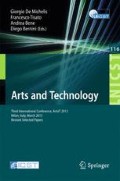Abstract
How does the individual behavior of a musician change in solo Vs. creative joint action? In this paper we consider music performance, an ideal ecological test bed to investigate non-verbal social behavior, to compare the expressive movement of violinists when playing solo or in a string quartet ensemble. In the presented study, by measuring its Sample Entropy, we observe that the movement of a musician’s head in creative joint action is more regular with respect to the solo condition.
Access this chapter
Tax calculation will be finalised at checkout
Purchases are for personal use only
Preview
Unable to display preview. Download preview PDF.
References
Knoblich, G., Butterfill, S., Sebanz, N.: Psychological research on joint action: theory and data. The psychology of learning and theory: Advances in research and theory, vol. 54. Elsevier, San Diego (2011)
King, E.C.: The roles of student musicians in quartet rehearsals. Psychology of Music 34(2), 262–282 (2006)
Glowinski, D., Mancini, M., Rukavishnikova, N., Khomenko, V., Camurri, A.: Analysis of dominance in small music ensemble. In: Proceedings of the AFFINE Satellite Workshop of the ACM ICMI 2011 Conference, Alicante, Spain (November 2011)
Camurri, A., Coletta, P., Varni, G., Ghisio, S.: Developing multimodal interactive systems with EyesWeb XMI. In: Proceedings of the 7th International Conference on New Interfaces for Musical Expression, pp. 305–308. ACM Press, New York (2007)
Glowinski, D., Dael, N., Camurri, A., Volpe, G., Mortillaro, M., Scherer, K.: Towards a Minimal Representation of Affective Gestures. IEEE Transactions on Affective Computing 2(2), 106–118 (2011)
Castellano, G., Villalba, S.D., Camurri, A.: Recognising Human Emotions from Body Movement and Gesture Dynamics. In: Paiva, A.C.R., Prada, R., Picard, R.W. (eds.) ACII 2007. LNCS, vol. 4738, pp. 71–82. Springer, Heidelberg (2007)
Caprara, G.V., Barbaranelli, C., Borgogni, L., Perugini, M.: The“ big five questionnaire”: A new questionnaire to assess the five factor model. Personality and Individual Differences (1993)
Watson, D., Clark, L.A., Tellegen, A.: Development and validation of brief measures of positive and negative affect: The PANAS scales. Journal of Personality and Social Psychology, 54(6), 1063–1070 (1988); Systems and turbulence, pp. 366–381. Warwick (1980)
Vesper, van der Wel, R., Knoblich, G., Sebanz, N.: Making oneself predictable: Reduced temporal variability facilitates joint action coordination. Experimental Brain Research 211, 517–530 (2011)
Varni, G., Mancini, M., Volpe, G., Camurri, A.: Sync’n’Move: social interaction based on music and gesture. In: Daras, P., Ibarra, O.M. (eds.) UCMedia 2009. LNICST, vol. 40, pp. 31–38. Springer, Heidelberg (2010)
Glowinski, D., Coletta, P., Volpe, G., Camurri, A., Chiorri, C., Schenone, A.: Multi-scale entropy analysis of dominance in social creative activities. In: Proc. of the Intl ACM Conf. on Multimedia, pp. 1035–1038. ACM (2010)
Author information
Authors and Affiliations
Editor information
Editors and Affiliations
Rights and permissions
Copyright information
© 2013 ICST Institute for Computer Science, Social Informatics and Telecommunications Engineering
About this paper
Cite this paper
Glowinski, D., Mancini, M., Camurri, A. (2013). Studying the Effect of Creative Joint Action on Musicians’ Behavior. In: De Michelis, G., Tisato, F., Bene, A., Bernini, D. (eds) Arts and Technology. ArtsIT 2013. Lecture Notes of the Institute for Computer Sciences, Social Informatics and Telecommunications Engineering, vol 116. Springer, Berlin, Heidelberg. https://doi.org/10.1007/978-3-642-37982-6_15
Download citation
DOI: https://doi.org/10.1007/978-3-642-37982-6_15
Publisher Name: Springer, Berlin, Heidelberg
Print ISBN: 978-3-642-37981-9
Online ISBN: 978-3-642-37982-6
eBook Packages: Computer ScienceComputer Science (R0)

